The research paper published by IJSER journal is about Optimization of Principal Dimensions of Radial Flow Gas Turbine Rotor Using Genetic Algorithm 1
ISSN 2229-5518
Optimization of Principal Dimensions of Radial Flow Gas Turbine Rotor Using Genetic Algorithm N.Surekha,Dr.Srinivas Kolla, Deva Raj.Ch.,K.Sreekanth
—————————— ——————————
as turbines are one of the key energy producing devices of our generation. A radial turbine stage is differential form an axial turbine stage by having the fluid undergo a significant change in passing through the rotor [6]. A preliminary design and analysis procedure allows the key turbine dimensions to be specified and the performance predicted at an early stage [10]. The complete design of the inward flow radial (IFR) turbine rotor requires the aero- thermodynamic, structural and manufacturing criteria to be satisfied simultaneously. The design specifications normally include the mass flow rate of the working fluid, pressure ratio, and in some cases, rotational speed [1]. Radial turbine design is dictated by criteria like specific speed and/or velocity ratios. For small capacity plants the size of the turbine wheel needs to be reduced and thus the rotational speed increased in order to reach a high efficiency [2]. The choice of the principal dimensions of a turbine rotor for a given set of inlet design specifications can be found by solving aerodynamic equations. An analytical method is indeed difficult and can be very time consuming, especially if the complete procedure has to be repeated for different cases. In view of this, numerical optimization techniques can be a useful tool to problems involving a large number of variables [2]. The freedom of the choice of tip diameter d2 and the tip width of the rotor
b2 that would be necessary for optimum isentropic
————————————————
N.Surekha, Phd.Scholor and Lectiurer, Department of Mechanical
Engineering ,MBTS Govt.Polytechnic College,Guntur,INDIA
optimization procedure will be a useful tool to determine the principal dimensions of the rotor.
Optimization is the act of obtaining the best result under given circumstances. In design of any engineering system objective is to either minimize the effort or maximize the desired benefit, since the effort required or the benefit desired in any practical situation can be expressed as a function of certain decision variables. Among the heuristics algorithms, the most common and used ones are the Evolutionary Algorithms, and in particular the Genetic Algorithms (GA)[9]. They are the most robust, since they can be used for real and discrete variables, in highly or weakly non-linear problem types, for global search or refinement, and also for the resolution of multi-objective problems. GA’s are fundamentally different than other optimization techniques. In this paper an attempt is made to solve the non-linear optimization problem for inward flow radial turbine described in the past literature using Genetic Algorithms for given inlet design speciation. In this paper, the given design conditions for the turbine are a power of 60 KW running at 60 000 rpm.
The choice of the principal dimensions of a turbine rotor for a given set of inlet design specifications, as shown in Table
1, can be found by solving equations (1) to (4). An analytical
method is indeed difficult and can be very time consuming,
especially if the complete procedure has to be repeated for different design cases.
Dr.Srinivas Kolla Professor, Department of Mechanical Engineering,
RVR&JC College of Engineering,Gunrtur,Kolla_neha@Rediffmail.com
Deva Raj.Ch., Assistant Professor,Department of Mechanical Engineering,
![]()
d2 N
![]()
60
2 u2
pe

1
1)
RVR&JC College of Engineering,Gunrtur,chdevaraj@gmail.com
C T
(
c p
K.Sreekanth, Assistant Professor,Department of Mechanical Engineering, p i
RVR&JC College of Engineering,Gunrtur
efficiency of the turbine stage is restricted by the specified rotational speed and power output [1]. Hence, an
IJSER © 2012 http://www.ijser.org
s
i
International Journal of Scientific & Engineering Research Volume 3, Issue 12, Decembe r-2012 2
ISSN 2229-5518
c d N
1
1 2
M 2
(2)
The generic mathematical formulation of an optimization problem is thus:
cos ![]()
w2 2 2
u2![]()
![]()
![]()
60
C pTi
1M 2
1
Find X =
1
2 1
![]()
1
![]()
M 2
(3)
b2
p i 1
![]()
1 2
That maximizes or minimizes, f (X)
m C T
![]()
2
d2
d2 Pi
B f 2
M 2 sin 2
Subjected to the constraints:
gj (X) <0, j=1, 2…m
where the blockage factor at the rotor inlet can be given by
hj (X) =0, j=1, 2… p
Where X is an n-dimensional vector called vector of the
B f 2
1
1 t
![]()
![]()
Nb
design variables, f(X) is defined as the Objective function,![]()
m C pTi
d 2 P
P
P
d 2
1
1/ 2
and the constraints gj(X), hj(X) are inequality constraints
and equality constraints respectively. The latter problem is called constrained optimization problem, while if the constraints are not present, the problem is called
unconstrained optimization problem.![]()
![]()
i i 1 P
![]()
1
P
To illustrate the working principles of GA’s, we first
2
tt 1
2
e /
i
2
consider an unconstrained optimization problem. Later, we
shall discuss how GA’s can be used to solve a constrained
de
dh
![]()
![]()
B f 2
4
![]()
1 d
![]()
d
optimization problem. Let us consider the following
2
2
optimization problem:
Maximize f (x),
![]()
1
M er sin e
1
2 1
(4)
xi (L) xi xi (U), i=1, 2…N.
Although a maximization problem is considered here, a
![]()
1
M er
sin 2
minimization problem can also be handled using GA. In
2
order to use GA to solve the above problem, variables xi’s
are first code in some string structures. It is important to
where the blockage factor at the rotor inlet can be given by
mention here that the coding of the variables is not
B 2
![]()
N b t1
d 2
absolutely necessary. There exists some study’s where GA’s
f 1 d
d 2 d h
d 2
are directly used on variables themselves, but here we shall ignore the exceptions and discuss the working principle of
Table 1. Input data at design point of IFR turbine
i 3.6
In view of this an optimization technique can be a useful tool to problems involving large number of variables. Many algorithms have been described in [14]. Genetic algorithm is one of these for solving constrained non-linear optimization problem. This program has been widely used for most of engineering problems. An adoption of this numerical optimization technique to the design of the IFR turbine rotor is now applied and described.
simple genetic algorithm. Binary coded strings1’s and 0’s
are mostly used. The length of the string is usually
determined according to the desired solution accuracy.
GA’s mimic the survival of the fittest principle of
nature to make a search process. Therefore, GA’s are naturally suitable for solving maximization problem. Minimization problems can also be converted in to maximization problems by some suitable transformation; in general, a fitness function F(x) is first derived from the objective function and used in successive genetic operations. Certain genetic operators require that the fitness function be non-negative, although certain operator’s do not have this requirement. For the maximization problems the fitness function can be considered to be same as the objective function or F (x) =f (x). For the minimization problems, the fitness function is an equivalent maximization problem chosen such that the optimum point remains unchanged. A number of such transformations are possible. The fitness function F (x) =1/ (1+f (x)) is often used.
IJSER © 2012 http://www.ijser.org
International Journal of Scientific & Engineering Research Volume 3, Issue 12, Decembe r-2012 3
ISSN 2229-5518
This transformation does not alter the location of the
d 2
X (1)
![]()
minimum, but converts a minimization problem to an
equivalent maximization problem. The fitness function
u2 cs X (2)
X (3)
2 X (4)
value of the string is known as the string’s fitness.![]()
M X 2
X (5)
The operation of GA begins with a population of
random strings representing design or decision variables.
b2 d 2 X (6)
M X (7)
er
There after, each string is evaluated to find the fitness
e
X (8)
![]()
de d 2 X (9)
value. Three main operators – reproduction, cross over, and
d h d 2
X (10)
mutation to create a new population of points then operate
the population. The new population is further evaluated and tested for termination. If the termination criterion is not met, the population is iteratively operated by the above three operators and evaluated. This procedure is continued until the termination criterion is met. One cycle of these operations and the subsequent evaluation procedure is known as generation in GA’s technology. Genetic algorithm has also been used to solve constrained optimization problems. Although different methods to handle constraints have been suggested, penalty function method has been mostly used. In penalty function method, a penalty term corresponding to the constraint violation is added to the objective function. In most cases, bracket operator term is used [14]. In constrained minimization problem, the objective function f (x) is replaced by the
penalized function:
where d2 = rotor tip diameter, u2/cs = velocity ratio, 2 = absolute flow angle at rotor inlet, 2 = cw2/u2 = loading factor, M2 = Mach no. at rotor inlet, b2/d2 = width to tip diameter ratio, Mer = Mach no. at exducer tip diameter, e = relative flow angle at exducer tip diameter, de/d2 = exducer to rotor tip diameter ratio, and dh/d2 = hub to tip diameter ratio.
The main objective of problem is to minimize the
rotor tip diameter and it can be stated as Minimize rotor tip diameter,
f x d2
(i) Equality constraints
g1 56 X (1)1 14 X (2)
![]()
1 0.165 X (5)2
g cos X (3) 3X (4) X (1)
n K
![]()
![]()
2 2
0.33X (5)2
P( x) f ( x) u j
j 1
g x
v k hk x
k 1
0.00235 X (1) 0.008N b
Where uj and vk are penalty coefficients, which are usually
g 3 X (6)
X (1) 2
![]()
![]()
X (1)
kept constant throughout GA simulation. The fitness
1 0.833 X (5) 2 3.5
function is formed by the usual transformation:
F ( x) 1![]() 1 Px . The final task of the formulation
1 Px . The final task of the formulation
X (5) sin X (3)
0.0017
0.01N b
procedure is to set the minimum and maximum bounds on
each design variable Since GA s is population based search
g 4
X (1) 2
![]()
0.5751
![]()
X (1)X (9) X (10)
techniques; therefore the final population converges to a region, rather to point.
The frame size and weight of an IFR turbine is often an important parameter consideration, in view of this, the size of the turbine plays an important role in determining the overall size of such turbine. Therefore the aim is to minimize the rotor tip diameter d2, and this can be considered a constraint optimization problem. The
X (7)X (9) 2 X (10) 2 sin X (8)
![]()
1 0.833 X (7) 2 sin 2 X (8)3.5
These equality constrained are obtained by substituting the given inlet design specification in to equation (1) to (4).
(ii) Side constraints
g5 X (1) 0.2 0 ,
g6 X (2) 0.707 0 , g7 X (3) 21 0 , g8 X (4) 1 0 ,
g9 X (5) 1 0 ,
procedure to solve such a problem is described as follows,
g10
X (6) 0.15 0 ,
Selection of Main Principal Parameters of a Turbine Rotor. The choices of selecting the principal dimensions (Design Variables) of a turbine rotor to solve this optimization problem are:
g11 X (7) 1 0 ,
g12 25 X (8) 0 ,
g13 X (9) 0.75 0 ,
IJSER © 2012 http://www.ijser.org
International Journal of Scientific & Engineering Research Volume 3, Issue 12, Decembe r-2012 4
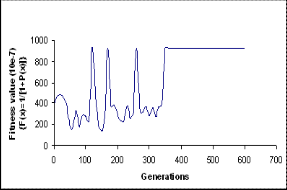
ISSN 2229-5518
g14 0.25 X (10) 0
A computer program has been developed for Genetic algorithm to solve this non-linear optimization problem
The optimization computer program was run for different number of blades ranging from 12 to 20, in accordance with the assumed efficiency. The final out put results for each run give the numerical values of the matrix X. Fig.1 to Fig.7 shows the variation of maximum fitness value over the number of generation for different number of blades ranging from 12 to 17 and the procedure is repeated for remaining number blades and convergence criteria is considered. These graphs show that, the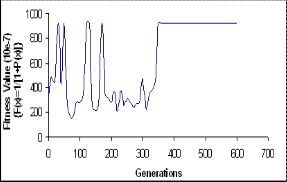
Fig1.Fittness Vs Generations for 12 Blades
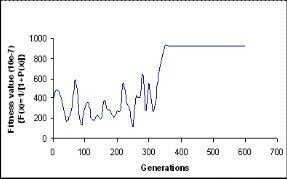
Fig2.Fittness Vs Generations for 13 Blades
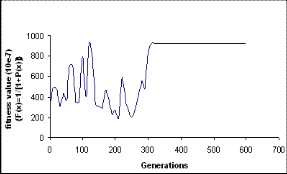
Fig3.Fittness Vs Generations for 14 Blades
Fig4.Fittness Vs Generations for 15 Blades
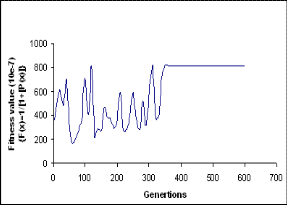
Fig5.Fittness Vs Generations for 16 Blades
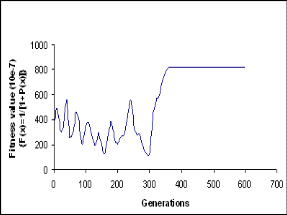
Fig6.Fittness Vs Generations for 17 Blades
Convergence criteria are reached around 350 to 400 generations for different number of blades. And the optimum criterion is obtained where the fitness value at each generation is converged and gives the optimum values of the design variables for different number of blades
IJSER © 2012 http://www.ijser.org
International Journal of Scientific & Engineering Research Volume 3, Issue 12, Decembe r-2012 5
ISSN 2229-5518
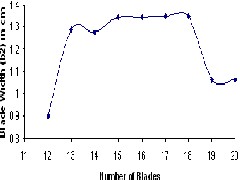
T a b l e 2 : O p t i m u m v a l u e s o f t h e d e s i g n v a r i a b l e s f o r d i f f e r e n t n o . o f b l a d e s b a s e d o n o p t i m i z a t i o n p r o g r a m
F i g 8 V a r i a t i o n o f b l a d e w i d t h v s n o . o f b l a d e s
T a b l e 3 : D e s i g n d a t a o u t p u t f o r t u r b i n e r o t o r
Table 2 gives optimum values of design variables obtained after running the program for Genetic Algorithm
for different number of blades. Fig 7 and Fig 8 shows the objective function d2 and blade width b2 plotted against the number of blades. It was found that the change in rotor tip diameter and blade width is relatively small over the number of blades ranges from 12 to 20 as shown in the plot. Therefore the scale has been enlarged to show clearly the trends of both b2 and d2. It shows that the minimum value of d2 occur at blade number 12, even tough the difference is very small and can be ignored over total blade range. As one would expect the tip width increases over the blade range because increasing the number of blades will reduce the flow passage area. To keep the mass flow rate the same the blade width must increase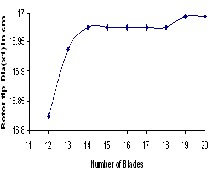
Fig 7 Variation of rotor tip diameter vs no. of blades
It was reported by A. Whitfield [11] that the maximum efficiency was reached with the number of blades Nb = 17. The corresponding values of d2 = 16.975cm and blade width b2 = 1.35cm, respectively, which does not differ much at number of blades in the range of 12 and 20 as shown in the Fig 8. The design data out put of the turbine rotor obtained using the optimization technique is given in the Table 3. It should be noted her that the turbine efficiency term is assumed as 0.87.
The optimization computer program was run for different number of blades ranging from 12 to 20, in accordance with the assumed efficiency. The optimum values of design variables are obtained after running the program for Genetic Algorithm .It is found that only very few best individuals are there in first few generations but later reproduction operation which is based upon the best individual, cross over and mutation operation leads to fill successive generations with only the best individuals those individuals which violate the constraints have low fitness value and those which do not violate the constraints have high fitness values. Among that individual, which does not violate the constraints, the best individual is selected which will have optimum v a l u e.
IJSER © 2012 http://www.ijser.org
International Journal of Scientific & Engineering Research Volume 3, Issue 12, Decembe r-2012 6
ISSN 2229-5518
TABLE4
NOMENCLATURE
![]()
Quantity Magnitude
![]()
b - Blade width in mm or cm
Bf - Blockage factor
C - Absolute flow velocity in m/sec
Cp - Specific heat capacity at constant
pressure KJ/Kg K.
d - Diameter in cm or mm
. - Mass flow rate Kg/s
M - Absolute Mach Number Mr - Relative Mach Number N - Rotational speed, rpm Nb - Number of Blades
Re - Reynolds number
t - Blade thickness mm/cm
T - Stagnation temperature
U - Rotor tip velocity m/s
- Absolute flow angle relative to axial
direction
- Relative flow angle relative to axial
direction
- Ratio of specific heats
- Efficiency
- Angular velocity, rad/sec
Subscripts:
0 - Stagnation condition
1 - rotor outlet station at mean
2 - rotor inlet station
e - exit condition, exducer
R E F E R E N C E S
[1]. Ebaid M.S.Y, Al-Hamdan Q.Z. Optimization techniques for
designing an inward flow radial turbine rotor. Proc. Instn. Mech. Engrs Vol 218. Part A. J. Power and Energy 2004.
[2]. Ebaid M.S.Y, Bhinder F.S, Khdairi G.H. A unified approach for designing a radial flow gas turbine. Journal of Turbo machinery-Transactions of The ASME 125 (3): 598-606 Jul
2003
[3]. H.Saravanamutoo, G.F.C.Rogers and H.Cohen. Gas Turbine
Theory, first edition, Pearson Education Pvt. Ltd., 2001 [4]. Kalyanmoy Deb. Optimization for Engineering Design:
Algorithms and Examples, Prentice-Hall of India Pvt.Ltd.
1998
[5]. Krzysztof Kostrzewa. Optimization of Radial Turbine By
Means Of Design of Experiment.
[6]. N.C.Baines, Introduction to Radial Turbine Technology, VKI Lecture Series 1992-05.
[7]. N.C.Baines and C.H.Sieverding, Radial Turbines. Von Korman Institute for Fluid Dynamics, Lecture series 1992-05, April 6-10, 1992.
[8]. Nick Baines. Radial Turbines: An Integrated Design Approach. Concepts NREC, Chipping Norton, UK. ncb@conceptsnrec.com
[9]. Raphael T. Haftka. Multidisciplinary Aerospace Design Optimization. American Institute of Aeronautics and Astronautics. www.sciencedirect.com
[10]. Suresh Sampath, Riti Singh. An Integrated Fault Diagnostics Model Using Genetic Algorithm. Journal of Engg for Gas Turbines and Power Jan 2006, ASME Vol. 128 / 49.
[11]. Whitfield. A. Non Dimensional Conceptual Design of Radial
Inflow Turbines. VKI Lecture Series 1992-05.
IJSER © 2012 http://www.ijser.org